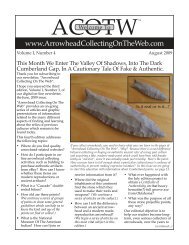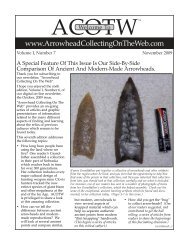Rock, Paper, Scissors - Arrowhead Collecting On The Web
Rock, Paper, Scissors - Arrowhead Collecting On The Web
Rock, Paper, Scissors - Arrowhead Collecting On The Web
Create successful ePaper yourself
Turn your PDF publications into a flip-book with our unique Google optimized e-Paper software.
ACOTW<br />
<strong>Arrowhead</strong> <strong>Collecting</strong> <strong>On</strong> <strong>The</strong> <strong>Web</strong><br />
<strong>Arrowhead</strong> <strong>Collecting</strong> <strong>On</strong> <strong>The</strong> <strong>Web</strong><br />
TM<br />
smaller limit for handholding during pressure fl aking. This<br />
will depend on hand size and fi nger strength, of course,<br />
but there are ways to lower the minimum size limit. Some<br />
pressure fl aking can continue if you lay the point on a pad,<br />
on the ground, or on<br />
some other support.<br />
This works well for<br />
minor edge trimming/<br />
straightening or minor<br />
shaping, but it is unlikely<br />
that much invasive fl aking<br />
can be accomplished in<br />
this manner. <strong>The</strong> technique<br />
does not allow generation<br />
of enough force for invasive<br />
fl aking, particularly in basalt.<br />
An exceedingly thin, nicely<br />
pressure fl aked, small preform<br />
can be generated as the tip of a<br />
larger biface, which allows for<br />
a strong grip on the piece while<br />
knapping. Subsequent to being<br />
broken off , whether purposefully or<br />
accidentally, that biface tip requires<br />
minimal further work to make a refi ned<br />
projectile point.<br />
After quarrying from blocks or reducing<br />
irregular cores, the most frequent starting<br />
point in Martis projectile point percussion/<br />
pressure replication, at least for the author, is<br />
a fl ake about 10 mm. thick. Callahan’s (1979)<br />
basic reduction sequence is nearly always<br />
involved: Stage 1, unretouched blank; Stage<br />
2, roughout by edging; Stage 3, fi rst round of<br />
invasive thinning fl akes; Stage 4, second round<br />
of invasive thinning fl akes; and Stage 5, careful<br />
fi nishing of plan form and straightening of edges.<br />
<strong>The</strong> stages often fl ow together with no break, and<br />
it is rare that a stage can be skipped. <strong>The</strong> latt er is<br />
particularly true if the knapper starts on a relatively<br />
thin blank (six mm. or less thick) that possesses<br />
excellent camber, already foreshadowing knife or projectile<br />
point cross-sectional geometry. <strong>On</strong>ly very rarely is a blank<br />
thin enough, and cleanly precambered enough, to allow<br />
fi nal main fl ake scars to be created on the fi rst rapid pass<br />
of thinning fl akes, thus bypassing one (at most two) of<br />
Callahan’s (1979) stages, and moving directly from Stage 2 to<br />
Stage 4 (or early Stage 5).<br />
Unfortunately, even small, thin blanks nearly always have<br />
irregularities that require much work, such as thick edges,<br />
cortex, ridges, fl aws, inclusions, and curvature. To these<br />
problems are added the myriad knapping errors that must<br />
be cleaned up, and to which even the best knappers are<br />
particularly prone when working with basalt.<br />
It should also be noted that a thin fl ake blank with a high<br />
width/thickness ratio will obtain a lower ratio during initial<br />
edging, so that substantial work is sometimes required to get<br />
the fl ake back to the very high ratio of Stage 4 bifaces.<br />
With a Martis projectile point that seems incredibly thin and<br />
pervasively well-fl aked with an organized fl ake scar<br />
This exceptional example of a basalt arrowhead was found<br />
by John Cockrell in the 1950’s along the Columbia River near<br />
Portland, Oregon. “Wallula Gap Rectangular Stemmed” points<br />
date to the Developmental to the Historic, from 1000 to 200 B.P.<br />
This Wallula Gap point measures 1-1/16” long by 5/8” wide.<br />
patt ern, it can be assumed that a very substantial amount of<br />
concentrated work went into it.<br />
<strong>On</strong> the basis of analysis of extensive recent collections<br />
from Martis Valley, Ataman et al. (1999) suggested that<br />
Middle Archaic projectile points there were produced<br />
through pure pressure fl aking on very thin fl ake blanks<br />
(with no percussion) about 25% of the time. This technique<br />
is possible; indeed, “wafer thin” dart points are common<br />
in archaeological assemblages, and often exhibit large<br />
remnants of the original fl ake-release surface, appearing<br />
as if percussion might have been bypassed. However, in<br />
the production of basalt fl ake blanks from cores, fl akes<br />
with thinly tapered edges all the way around and about<br />
the right size for projectile point generation are rare;<br />
the fact is that nearly all come off with at least<br />
one thick edge, which usually requires<br />
percussion reduction.<br />
Furthermore, practice shows that<br />
even small, thin fl ake blanks<br />
start wider (usually<br />
much wider) than<br />
the conceived<br />
point and need<br />
to be narrowed.<br />
Such a procedure is<br />
far quicker and easier<br />
with a percussor than with<br />
a pressure fl aker, and thus<br />
easier on the hands and<br />
wrists, so it does not make<br />
sense to start with the<br />
pressure fl aker too early.<br />
Finally, the projectile<br />
point that is fi nished with<br />
pressure fl aking may not<br />
show any detectable trace<br />
of the initial percussion<br />
edging. In the author’s<br />
opinion, all pressure strategies in basalt are and were rare.<br />
Serrated Martis projectile points are not uncommon.<br />
Serration usually consists of closely spaced, small<br />
denticulations that are best made with a specially modifi ed<br />
pressure fl aker. This procedure requires patience and skill.<br />
Usually it is the terminal stage in the knapping process.<br />
Most basalt pressure fl akes shatt er during detachment.<br />
Missing Transitional Forms<br />
For their respective fi eld areas near Truckee and in Lakes<br />
Basin, Neuenschwander (1994) and Duke (1998) pointed out<br />
that transitional forms between percussion fl aked bifaces<br />
and pressure fl aked projectile points are rare. Complete,<br />
“fi nished” preforms ready for commencement of pressure<br />
fl aking are not commonly found, nor are broken bifaces<br />
upon which pressure fl aking had been commenced. Duke<br />
(1998a) believed that crude percussion fl aked bifaces were<br />
often ends in themselves; in other words, they were intended<br />
to be tools, not simply preforms (also see Ritt er 1970).<br />
Moreover, most projectile points would have been knapped<br />
directly from small, thin fl akes requiring a minimum of<br />
percussion preparation.<br />
Volume II, Number 12 16<br />
December 2010








